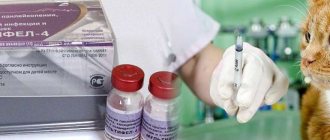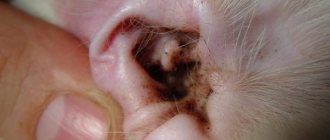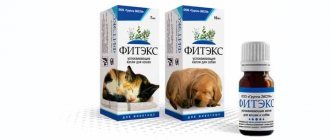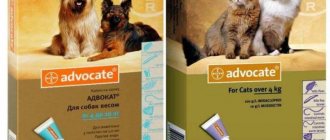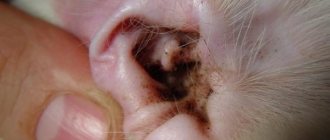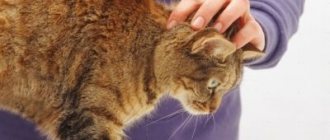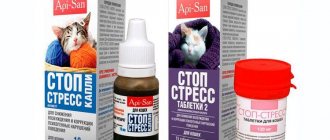Composition and action
The complex veterinary drug contains as active substances:
- cypermethrin;
- amitraz.
The first substance has a contact and systemic insectoacaricidal effect. It consists of blocking the parasite’s nerve impulses, which leads to paralysis and subsequent death of the insect. Amitraz acts on certain receptors of the parasite, causing disruption of motor reflexes. The result of the drug is paralysis and death of the insect.
The combined drug Tsipam exhibits pronounced activity against ectoparasites:
- fleas;
- lice eaters;
- lice;
- ticks that parasitize pets - cats and dogs.
The drug is used externally, applied to the animal’s body, then its components are distributed over the pet’s skin, accumulating in the upper layers of the skin, sebaceous glands, and hair follicles. This ensures a prolonged effect of the drug, which reliably protects the animal from ecoparasites.
Important!
Moderately dangerous for cats and dogs, the drug is toxic to fish and aquatic animals, as well as to bees.
Tsipam ear drops 20ml
217 R
Composition 1 ml cypermethrin 3 mg amitraz 2 mg Excipients: dimethyl sulfoxide - 100 mg, polyethylene oxide-400 - up to 1 ml. Pharmacological action Combined insectoacaricidal drug. Cypermethrin and amitraz, which are part of the drug, have pronounced insectoacaricidal activity against the preimaginal and imaginal phases of development of lice, fleas, lice, as well as ixodid, demodectic and sarcoptic ticks that parasitize dogs, cats and fur-bearing animals. Cypermethrin has a contact and systemic insectoacaricidal effect, the mechanism of which is to block the transmission of nerve impulses, which causes impaired coordination of movements, paralysis and death of ectoparasites. Amitraz is an acaricide of the formamidine group, has intestinal and contact effects. The mechanism of its action is to act on the octopamine receptors of ticks, which causes a blockade of the conduction of nerve impulses, impaired motor reflexes, paralysis and death of the parasite. After applying the drug to the skin, its active components are gradually distributed over the entire surface of the animal’s body, are practically not absorbed into the systemic bloodstream, and accumulate in the epidermis, hair follicles and sebaceous glands, providing a long-term insectoacaricidal effect and protecting the animal from ectoparasites. In terms of the degree of impact on the body, Tsipam is classified as a moderately hazardous substance (hazard class 3 according to GOST 12.1.007-76); in recommended doses it does not have a local irritant, skin-resorptive or sensitizing effect. Toxic to bees, fish and other aquatic organisms. Indications Treatment for dogs, cats and fur-bearing animals: - otodectosis; - psoroptosis; - notohedrosis; - sarcoptic mange; - demodicosis; — entomoses; - damage by ixodid ticks. Contraindications: increased individual sensitivity of the animal to the components of the drug. The following cannot be treated with the drug: - animals during an infectious disease; — pregnant and lactating females; - puppies and kittens under 6 weeks of age. Auricular use of the drug in case of perforation of the eardrum is not allowed. Side effects When using Tsipam in accordance with the instructions, side effects and complications, as a rule, are not observed. In case of increased individual sensitivity and the occurrence of allergic reactions, the drug should be washed off with water and detergent and, if necessary, the animal should be prescribed antihistamines and symptomatic therapy. In case of an overdose, the animal may experience excessive salivation, muscle tremors, and vomiting. In this case, the drug is washed off with water and detergent and symptomatic treatment is used. Method of administration and dosage For otodectosis (ear scabies), the external auditory canal is cleaned of scabs and crusts with a swab moistened with the drug, then 3-6 drops of Tsipam are instilled into each ear (depending on the weight of the animal). In order to more completely treat the entire surface of the ear and ear canal, the auricle is folded in half lengthwise and its base is lightly massaged. Treatment is carried out twice with an interval of 3-5 days. In advanced cases of otodectosis complicated by otitis, antibacterial and anti-inflammatory drugs are prescribed. The drug must be administered into both ears, even in cases of otodectosis affecting only one ear. If necessary, the course of treatment is repeated. When animals are affected by psoroptosis, sarcoptic mange, notoedrosis and demodicosis, the drug is applied to the affected areas, previously cleared of scabs and crusts, at the rate of 0.5-1.0 ml/kg of animal weight, and then evenly distributed from the periphery to the center, covering borderline healthy skin up to 1 cm. For To prevent licking of the drug, animals are put on a cervical collar or muzzle, which is removed 15-20 minutes after applying Tsipam. Treatment is carried out 1-2 times a week until the animal’s clinical recovery, which is confirmed by two negative results of microscopic examination of skin scrapings. Animals with large areas of skin lesions are treated in two doses with an interval of one day, applying the drug first to one half of the affected surface of the body, and then to the other. To destroy lice, fleas and lice-eaters, animals are treated with Tsipam at the rate of 0.5-1.0 ml per 100 cm2 of body surface (depending on the condition of the coat). Tsipam, spreading the fur, is applied to the skin of the body in a thin stream, drawing lines at intervals of 3-4 cm from head to tail. 15-20 minutes after treatment, the animal’s fur is combed with a comb. Repeated treatments are carried out according to indications, but not more than once every 7 days. In order to prevent the breeding of fleas and re-infestation of animals, bedding, blankets and other care items are treated with Tsipam, applying a thin stream of stripes at the rate of 10 ml/m2 of surface. For 3 days, do not allow the animal to come into contact with the treated items, and before subsequent use, they are washed (washed) with detergent. To kill fleas in non-residential premises where animals are kept, walls up to 1 m from the floor level, floors and cracks are treated. Tsipam is applied in a thin stream at the rate of 20 ml per 6-7 m2, and then distributed with a swab over the entire surface to be treated. Treatment is carried out 2-3 times with an interval of 10-14 days. To destroy ixodid ticks on the body of an animal, Tsipam in an amount of 1-2 drops is applied to the tick and the place of its attachment to the skin. If the tick does not fall off spontaneously within 15 minutes, it is carefully pulled out of the animal’s body and destroyed. No specific effects of the drug during its first use and discontinuation were identified. Violations of the drug use regimen should be avoided, because this may reduce its effectiveness. If the next treatment is missed, it should be carried out as soon as possible in the same dose. Special instructions Tsipam should not be used together with other insectoacaricidal drugs for treating animals. Tsipam is not intended for use in food producing animals. Personal preventive measures When working with the drug Tsipam, you should follow the general rules of personal hygiene and safety precautions provided for when working with drugs. While working with the drug, smoking, drinking and eating are not allowed. After finishing work, wash your hands with warm water and soap. Do not stroke the area where the drug was applied and do not allow the animal near small children for 48 hours after treatment with the drug. People with hypersensitivity to the components of the drug should avoid direct contact with Tsipam. If allergic reactions occur or if the drug accidentally enters the human body, you should immediately contact a medical facility (bring with you the instructions for use of the drug or the label). Empty drug containers must not be used for household purposes; they must be disposed of with household waste.
Purpose
The main effect of the drug is aimed at treating diseases caused by ectoparasites in animals. Such pathologies include:
- otodectosis;
- notoedrosis;
- demodicosis;
- psoroptosis;
- sarcoptic mange.
Otodectosis is a disease caused by ixodid ticks. A microscopic parasite penetrates the auricle and ear canal, causing exudative inflammation of the hearing organ. The disease is characterized by the following symptoms:
- itching;
- local and sometimes general hyperthermia;
- the presence of brown exudate with a strong unpleasant odor.
It is not difficult to cure the pathology, but without treatment, serious complications may develop:
- secondary bacterial infections;
- partial or complete hearing loss;
- nervous diseases;
- brain damage, most often resulting in death.
Notoedrosus is also known as scabies, a parasitic skin disease that can affect cats when Notoedros Cati mites multiply on the skin. A microscopic mite lives in the outer layer of the skin, moves along the epidermis, gnawing passages in it, and feeds on dead skin cells. A domestic cat can become infected from a sick animal. Animals on free range are primarily at risk.
The disease can be identified by the characteristic papules (pimples) on the pet’s face and neck. The movement of the mite under the skin causes severe itching in the cat (hence the name of the disease - scabies). By scratching the affected areas of the skin, the cat itself carries the parasite throughout the body. Sharp claws injure the skin, which opens the way for opportunistic microorganisms. Tick infestation causes secondary bacterial infections. With scabies, a cat's skin becomes covered with pustules and crusts, and constant itching and a nervous state lead to exhaustion of the animal.
Another common disease caused by ectoparasites is demodicosis. The causative agent is a small Demodex mite, which lives in the sebaceous glands of domestic animals and feeds on epidermal cells and fatty secretions. Infestation can lead to severe skin diseases.
The first stages of infection can be determined by the following symptoms:
- severe itching;
- hair loss;
- ulcers on the body.
At risk are young animals, puppies and kittens, whose body’s immune system is significantly weaker than that of healthy adult animals. The disease develops in stages:
- at first you may notice that the pet begins to itch frequently and actively;
- scratches appear on the body;
- the skin is damaged, opening the opportunity for pathogenic microorganisms to penetrate through wounds and scratches into the body;
- hair begins to fall out - in the area of the muzzle, paws, hips, shoulder blades;
- A rash and hyperemia (redness) appear on the body.
Depending on the extent of the spread of the lesion, there is a local form of demodicosis (if there are no more than five lesions and their size does not exceed 2-3 cm in diameter) and a generalized one, if the lesion covers the entire body and causes complications and the development of a secondary bacterial infection.
Sarcoptic mange has similar symptoms to feline mange, but mostly affects dogs. Once on the animal's body, the female parasite gnaws passages and moves along the epidermis, feeding on it. And males die after fertilizing females. The disease is considered very contagious: at high humidity and an ambient temperature of +10...15 degrees, ticks can survive and retain the ability to reproduce for up to three weeks.
Application
Tsipam is used as prescribed by a veterinarian after conducting a clinical analysis for the presence of the parasite and determining its type. It is not recommended to use the drug for self-medication, since it is impossible to independently determine the cause of the disease without analyzing skin scrapings.
The method of administration and dosage depend on the diagnosis and purpose of using the drug. For ear scabies, 3-6 drops of medicine should be dropped into the ear canal, previously cleaned with lotion, then massage the auricle. You will need to treat the ears twice with an interval of 3-5 days. If inflammation (otitis) develops, the veterinarian will prescribe additional antibiotics and anti-inflammatory drugs.
Important!
You need to drip into both ears, even if only one is affected by mites. If a repeated analysis shows the presence of a parasite, the treatment is repeated.
For other diseases caused by ectoparasites, the medicine is used for external use, treating the affected areas of the skin. They must first be cleaned of scabs and crusts. Tsipam solution is applied at the rate of 0.5-1 ml/kg of animal body weight, distributed throughout the body. To prevent your pet from getting poisoned by licking the medicine, put a protective collar on it for 15-20 minutes. The pet should be treated twice a week until complete recovery is confirmed by microscopic examination of skin scrapings.
In case of flea infestation, your pet's skin should be treated with Tsipam. Having parted the fur, the liquid is applied to the body, starting from the withers and moving along the spine.
Important!
The same product can be used to treat the bedding and walls of the room where the animal is located.
Tsamaks: Tsipam, acaricidal ear drops, 10 ml
TsIPAM is a complex drug for the control of animal ectoparasites. The drug effectively destroys insects and their larvae, penetrating into them through the conticles and respiratory organs.
Effectively affects all classes of ectoparasites.
Awarded the gold medal of the All-Russian Exhibition Center in 1998.
The veterinary drug TsIPAM ear drops for animals is used not only on animals, but also to kill fleas indoors.
Used for external use.
COMPOUND
Active ingredients: cypermethrin (0.3%), amitraz (0.2%); excipients - dimethyl sulfoxide and polyethylene oxide.
MECHANISM OF ACTION
TsIPAM ear drops for animals is an insecto-acaricide with contact-intestinal action. It is effective when used against sarcoptic, demodectic, and ixodid ticks, as well as fleas and lice-eaters in animals. Cypermethrin and amitraz, with the help of auxiliary components, penetrate deeply into the epidemos and hair follicles, where ectoparasites mainly nest. The drug effectively destroys insects and their larvae, penetrating into them through the conticles and respiratory organs.
INDICATIONS FOR USE
The veterinary drug TsIPAM ear drops for animals is used to treat otodectosis (ear scabies), otitis media and notoendrosis.
DOSAGE AND METHOD OF APPLICATION
Treatment for notoedrosis. If areas of the head are affected by scabies mites, the drug is applied to the affected areas of the skin at the rate of 1-2 ml (20-40 drops) per 500 cm2. Treatment is carried out 2-3 times with an interval of 6-7 days.
Treatment for otodectosis (ear mites). The outer and inner surfaces of the ears are wiped with a swab moistened with the preparation. The drug is applied to the auricle, dripping 3-6 drops into each bottle (depending on the size of the animal). For more complete contact of the drug with the affected surface, the auricle is folded in half lengthwise and its base is lightly massaged. Treatment is carried out 2 times with an interval of 3-5 days. The drug must be administered into both ears, even if only one is diseased. In advanced cases of otodectosis, complicated by otitis, continue treatment until recovery.
INTERACTION WITH OTHER MEDICINES
The veterinary drug TsIPAM ear drops for animals is not recommended for use in conjunction with other external drugs. In advanced cases, antibacterial and anti-inflammatory agents can be used simultaneously.
If otitis is caused by an allergy, it is necessary to simultaneously use the veterinary drug (feed additive) Tsamaks for animals to relieve intoxication.
OVERDOSE
There is virtually no risk of overdose, since the drug acts locally.
SIDE EFFECTS
When using the veterinary drug TsIPAM ear drops for animals in accordance with the instructions, no side effects or complications are observed.
CONTRAINDICATIONS
TsIPAM ear drops for animals belong to hazard class 3 (GOST 12.1.007). In recommended doses it does not have a local irritant, skin-resorptive or sensitizing effect.
It is not recommended to treat with the drug: animals with infectious diseases, pregnant and lactating females, as well as young animals under 6 weeks of age.
The drug is toxic to fish and bees.
STORAGE CONDITIONS
Store in a dry place, protected from light, at a temperature of 4 to 25 degrees C, out of the reach of children.
BEST BEFORE DATE
2 years.
PERSONAL SAFETY MEASURES
When finishing processing, you must wash your hands with soap.
If CIPAM gets on the mucous membranes, it must be washed off immediately with cold water.
It is prohibited to use bottles of the drug for household purposes; they are thrown into garbage containers.


